  |
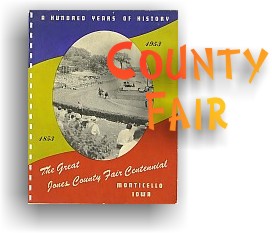 |
|||||||||||||||||
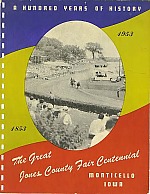
|
"Everything is ready for the Fair!" proclaimed 1883 fair bills, and many improvements had been made under President C. E. Wales and Secretary G. Leighhardts direction; two thousand dollars had been spent for building improvements, artesian well water from city wells had been piped to the grounds and a sidewalk had been constructed from the depot to the fair-grounds. The sidewalk resulted from heated protests of the ladies over the condition of their skirts from tramping through the mud, dust and weeds along the way. The interior of Floral Hall was bright with a new coat of whitewash. Fair goers of the day still recall removing their shoes after touring each wing to empty out the white sand which comprised the floor. The horse races that year, for the first time, were run under National Association rules after criticism of jockeying and sportsmanship in 1882. People were becoming more conscious of the time and effort required to produce their growing Fair. An editorial in the local paper expressed it as follows: |
|||||||||||||||||
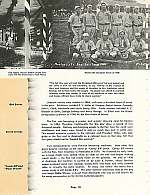
|
||||||||||||||||||
| Livestock entries were notable in 1884, with over a hundred head of swine in the pens. Exhibitors included E. V. Miller of Viroqua; Ezekiel Moore, Cascade; John L. Clark, Monticello and Lewis Starry, Olin. Cattle winners included A. C. Gleason of Delhi, George Lathrop and Henry George. H. Eilers took the Grand Sweepstakes premium of $100 for the best stable of horses.
The Fair was becoming a greater and greater drawing card for Eastern Iowa. In 1884, Thursday, traditionally the 'big day' drew a record of five thousand people. Railway cars bringing people to the Fair from the north were insufficient, and many were forced to ride on coach tops and in cattle cars. This caused extensive protests to the railroad, and President Wales who took pride in the Fair and in Monticello as a railroad town in that day, felt that fair goers should not be "herded like animals." Two concessionaires were likewise becoming traditions. Most older Fair goers became nostalgic at the name of "Candy Bill" Leech. Candy Bill moved with the Fair, from Anamosa to Monticello in 1874. He fastened his taffy hook on a large maple tree, tacked white oil cloth on the tree and began making cream candythe first hot candy made on the grounds. He died in 1930 at Anamosa, but tradition is carried on by Cecil R. Farmer, whose familiar screen enclosed stand now replaces Candy Bill's tree hook and taffy covered table in virtually the same location. To many 'old timers' the Monti Fair's cream candy is still Candy Bill's. The other familiar concession man of the day was Major Noble Winner, a dwarf from Monticello who was as well known for his saucy conversation as for his hot buttered popcorn. |
||||||||||||||||||
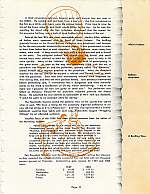
|
A third concession operator, became quite well known, too, one year in the 1880's. He vended cold root beer from a big vatthe first introduced at the fair as a drink, and many were the curious tasters. From time to time, he stirred the brew violently and froth would billow to the top. As he was dismantling his stand after the fair, onlookers discovered that the reason for the excessive frothing, was a sack of soap hidden in the bottom of the vat.
Fairs of the late '80's saw many memorable events. Manley Allen, celebrated Indian scout, appeared with his band of Sioux Indians. The thrilling spectacle known as the Grand Balloon Ascension was introduced, and became by far the most popular attraction for several years. It was guaranteed to make at least three ladies faint at each ascension. Hot air balloons, some ninety feet across, were used. A long trench was built with a fire at one end and a funnel at the other. The collapsed balloon was placed over the funnel, and small excited boys were allowed to hold the sides of the bag apart to help it fill more quickly. Many of the "oldsters" still recall the thrill of participating in this great event. As soon as the bag was completely filled with hot air, a parachute was hitched on and the performer, grandly called "The Aeronaut," seated himself on a trapeze attached to the parachute. When the daredevil reached the desired altitude he tripped a release and floated back to earth with the parachute. Such men (and occasionally women) were respected for their daring feat, and they felt their position keenly. One aeronaut interviewed before performing said, "I instinctively feel it dangerous and there naturally comes to my mind a recollection of all my moral shortcomings. I try to do right, but I presume all men are guilty of some sins." This performer was billed as Monsieur Trencaville for ascension watchers prefered the French flavor. He admitted his real identity as Dockstader of New York but declared, "I yield the palm to no aeronaut alive for daring." The Monticello Express stated the general view of the county Fair crowd when it said, "We have a liking for the customary dignified balloonist in his new silk hat sitting as if in a Palace Car." And thus was reprimanded a livelier balloonist wearing blue tights and skull cap, disdainfully tagged "Wriggling William" by an offended audience. Another facet of the 1888 Fair drew critical comment from the editor of the Wyoming Journal:
|
|||||||||||||||||
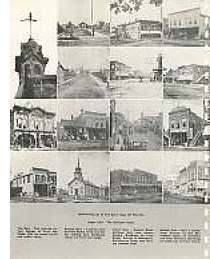 Fair president Sherman and Secretary Henry showed nothing but pleasure as they reported the most financially successful Fair yet held with ten thousand persons present on Thursday. Comparative gate receipts for 1887 and 1888 were: Fair president Sherman and Secretary Henry showed nothing but pleasure as they reported the most financially successful Fair yet held with ten thousand persons present on Thursday. Comparative gate receipts for 1887 and 1888 were:
|
||||||||||||||||||
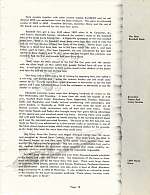 |
Gate receipts together with other income totaled $4,520.05 and an additional $200 was added later from the State Treasury. This gave an estimated surplus of $600 to $800. President Sherman, Secretary Henry and the rest of the board were re-elected for the next four years.
Baseball fans got a new thrill about 1889 when H. M. Carpenter, Sr., well known Monticello banker, introduced the catcher's mask to the baseball fans at the Great Jones County Fair. A Dyersville sportsman of the time recalled years later, "Back in my baseball days, forty years ago they used to take the ball on the first bounce, fifteen feet back of the batter. Never knew such a thing as a mask and boys took 'em in the bare hands like John L. and Jack Killian used to fight. This man Carpenter, he was considered the best ball catcher in these diggin's and "H. M.", when the new-fangled face protector was invented, had the first one anyone had seen here-about. "Well, when his team played at the Fair the first year with 'the catcher with the silver mask' as they called him, people flocked from all over to see him. It was quite a sensation to have a man stand in the shadow of the batter and take the ball off the bat as they said. "But long with it there was a lot of razzing by opposing fans who called it a rat trap, calf muzzle and I guess the veteran banker can still recall some names for it. Crowds came from great distances to Monticello to see the ball games and I rode horseback down from the settlement to Monticello to see the catcher in action." Adequate excursion trains were now bringing hundreds of visitors to the Fair Wednesday and Thursday. A train from the north left Fayette at 7:45 a.m., touched Brush Creek, Strawberry Point, Edgewood, Greeley, Delaware, Delhi and Hopkinton and finally arrived overflowing with passengers, and picnic baskets, in Monticello at 10:20 a.m. A train from the south out of Oxford Junction made connections with all east and west trains. Trains from Cedar Rapids and Farley also brought many Fair goers taking advantage of the special one and one-third round trip fares. Arriving trains were usually met with gala fanfare, supplied by bands playing in the bunting-decked depot park near the mermaid encrusted fountain. The jaunt to the Fair Grounds was made on foot (it was advertised as a five minute walk) or sometimes in one of the horse drawn hacks or buses which made breakneck dashes for the grounds, as the faster they went the more fares they could carry. Big livery firms like Connor and Hogan changed horses near the corner now occupied by Sacred Heart Catholic church. One team made the dash to the depot, loaded up and flew back to the corner where another team took over for the flight to the Fairgrounds. This was really a remarkable feat, and in dry weather residents on Sycamore Street reported dust made visibility impossible, while in rainy weather mud made the impossible impassable. In 1889 good weather prevailed and over three thousand people picnicked in the Grove and under the shade trees. The importance of the horse in those days was brought out by the horse show that year. There were large classes of roadsters, draft breeds, general work horses, Percherons, Percheron-Normans and Clydesdales. Special attention was also given a herd of Black Aberdeen Angus owned by W. S. Niles of Wyoming. It was, evidently an unfamiliar breed in this locality for the local newspaper predicted, "These glossy, hornless cattle will rapidly gain in favor." |

|
||||||||||||||||
 |
Great interest was aroused the following year, 1890, when Fair President Sherman announced, "Parties from abroad have written saying they will be at the Fair with Edison's greatest invention, the Phonograph. This will be a rare opportunity for those watching new discoveries in science to familiarize themselves with this wonderful machine." Many were the dimes paid for the privilege of sticking a tube in each ear and listening for a few minutes to whatever happened to be playing on the marvelous "Talking Machine."
Robert Ryerson also keynoted the progress of 1890 by displaying a large herd of antelope from Kansas - "Your last chance to see animals which will soon become as extinct as the buffalo with settlement of the Western Plains". Among the thousands who viewed such wonders was a delegation of 150 people from Dubuque, under the leadership of C. E. Wales who was now running the Julien Hotel in that city. For the most part, they represented Dubuque jobbers and manufacturers, who hoped to "strengthen commercial ties heretofore existing." They were met at the depot by the Ladies Cornet Band of Monticello and the Monticello Business Men's Association. They joined with the Dubuque Military Band, which had accompanied the delegation, for a grand parade through the flag decorated business district. The Fair continued to grow in favor and importance. Wrote Monticello's Editor Doxsee:
The sum of $3,100 was appropriated in 1891, from the town council's general fund, and the forty acre fairgrounds was purchased from the Union Driving Park Association. The land was to be used for park purposes the rest of the year. | |||||||||||||||||


© Copyright 1997-2013, The Art Department, © Copyright 2014-2020, Richard Harrison.
| ||||||||||||||||||
